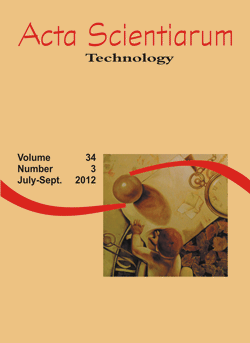<b>Evaluation of temperature and moisture response surface on the lipase from pumpkin seeds fermentation using <i>Aspergillus niger</i></b> - doi: 10.4025/actascitechnol.v34i3.12497
DOI:
https://doi.org/10.4025/actascitechnol.v34i3.12497Keywords:
agro-industrial waste, fermentation, solid state, microbial enzymeAbstract
Agro-industrial waste has shown great potential for use in solid-state fermentation due to its low cost and promoting the growth of microorganisms. This study evaluated the interaction between temperature and moisture response surface on lipase from the fermentation of pumpkin seed flour, using Aspergillus niger. Fermentations were performed in Petri dishes in an experimental design using a 22 matrix with four replications at the center point and four axial points, varying substrate moisture between 30 and 60% and temperature between 30 and 40ºC. The maximum hydrolytic activity (71.88 U g-1 dry weight) was obtained using flour with 30% moisture and 30°C temperature in 120 hours of fermentation. The interaction between fermentation temperature and initial moisture content of the residue was the parameter that most influenced the process at 95% significance level. The response surface analysis showed that the maximum lipase production can be obtained under temperature and moisture conditions of the flour ranging from 28 to 34.5°C and 25 to 32.5%; or between 32 and 40°C and 58 and 65%, respectively. Pumpkin seed flour showed potential for obtaining microbial lipase.
Â
Downloads
Downloads
Published
How to Cite
Issue
Section
License
DECLARATION OF ORIGINALITY AND COPYRIGHTS
I Declare that current article is original and has not been submitted for publication, in part or in whole, to any other national or international journal.
The copyrights belong exclusively to the authors. Published content is licensed under Creative Commons Attribution 4.0 (CC BY 4.0) guidelines, which allows sharing (copy and distribution of the material in any medium or format) and adaptation (remix, transform, and build upon the material) for any purpose, even commercially, under the terms of attribution.
Read this link for further information on how to use CC BY 4.0 properly.











8.png)




